Hugh Philp
(1782-1856)
Long Spoon
Long Spoon
Middle Spoon
"Laidlay" Putter

 This
genius made such beautiful and perfect wooden putters that he has come
to be regarded as the Amati or Stradivarius of Golf, and a genuine "Philp"
today is worth untold gold. The long narrow faces of these clubs and their
perfect balance are well known to connoisseurs (Golf Illustrated, 5 Oct.
1900: 12).
This
genius made such beautiful and perfect wooden putters that he has come
to be regarded as the Amati or Stradivarius of Golf, and a genuine "Philp"
today is worth untold gold. The long narrow faces of these clubs and their
perfect balance are well known to connoisseurs (Golf Illustrated, 5 Oct.
1900: 12).
It was Hugh Philp who first departed from the
primitive models of the stone age and began to make golf clubs that looked
as though they were intended for some gentler work than the crushing in
of an enemy's skull or the manufacture of broken flint for road-building.
Philp had an eye for graceful lines and curves, and his slim, elegant models
remain today things of beauty . . . . Moreover, as any fine crusted golfer
will tell you, Philp was the only man who ever knew how to make a perfectly
balanced wooden putter. The few specimens that still exist are acknowledged
"old masters," and are only to be exchanged against much fine gold (Harper's
Weekly, 2 Oct. 1897: 986).
Ever since his death in 1856, Hugh Philp has been universally
recognized as clubmaking's finest artisan. His clubs have been copied and
even forged, complete with his name. Philp's clubs were collectible 100
years ago. During the 1890s, a few people actually advertised in Golf,
a weekly periodical, offering to purchase his work at prices well above
the cost of any new club. His craftsmanship was often compared to that
of legendary and fabled violin maker Antonio Stradivari. Even a few aluminum
head putters made in the early 1900s were modeled after Philp's designs.
Philp was more than a talented clubmaker. His reputation
for being meticulous was legend:
Philp, in the olden times, was in the
wont of spending half a day agreeably putting the finishing touches to
a club after it had been handed over by his workmen as completed (The Golfer,
3 Nov. 1894: 184).
Today, Hugh Philp's legacy continues unabated. He is
considered the premier long nose clubmaker. He set the standard by which
the work of other clubmakers is measured. Decent examples of his clubs
are cherished.
The 42-inch long spoon pictured on the facing page
measures 5 3/4 inches in head length, 1 7/8 inches in width, and 1 inch
in face depth. Formerly owned by the Arbroath Golf Club, in Arbroath, Scotland,
this nearly unused example was displayed in their clubhouse for years before
being sold, to raise funds, in the early 1980s.
Because Hugh Philp's clubs have been highly sought
after ever since his death, many examples remain. Approximately 190 are
known. The opportunity to obtain a nice Philp is, in many ways, rarer than
the club itself. Many examples are held by golf organizations ranging from
the R&A and the USGA to such venerable clubs as The Honorable Company
of Edinburgh Golfers (Muirfield) in Scotland and the Los Angeles Country
Club. The remaining examples are primarily in the hands of serious collectors.
Therefore, a Philp in nice condition rarely becomes available.
The 42-inch Philp long spoon pictured on this page
is one of only five known examples marked "H. Philp" in script. Robert
Davidson routinely stamped his clubs in script, and Tom Hood stamped a
large percentage of his clubs in script, but Philp stamped only a few of
his clubs that way. It is thought that Philp used his script stamp to identify
either his personal clubs or the presentation clubs he made for a particular
person or occasion. This particular script-stamped clubhead measures 5
1/2 inches long, 2 inches wide, and 1 inch in face depth.
In 1899 a letter requesting information about Hugh
Philp was sent to the editor of Golf. The response came from the hand of
none other than Robert Forgan, the successor to Philp's business and one
of Philp's two former assistants. (In addition, Robert Forgan was related
to Hugh Philp through Forgan's marriage to the daughter of James Berwick,
Philp's brother-in-law.) Forgan's letter reads in part as follows:
Hugh Philp died April 6, 1856, in his
seventy-fourth year. He served no apprenticeship to club-making, but was
bred to the trade of joiner and house carpenter. He carried on that business
in Argyle Street, St. Andrews; and as there were no club makers in St.
Andrews at that time, the golfers began to take their clubs to him to be
repaired; and after a time they got him to come down to the links where
he had a shop where the Grand Hotel is now built. That would be somewhere
between 1820 and 1825 [during September of 1819 Philp was appointed official
clubmaker to the Society of Golfers at St. Andrews]. Some few years after
that he bought the property now occupied by Tom Morris, where he died in
1856. I don't know where he was born, nor how long he made clubs, but I
have heard him say that he made them for over fifty years. I was his assistant
when he died-his former assistant having left him in 1852 and opened a
club maker's shop on the ground where the Marine Hotel is now built. His
name was James Wilson, and was twenty- three years Mr. Philp's assistant.
[Andrew Strath was also an apprentice to Philp (Tulloch 1908, 22).] I was
four years Mr. Philp's assistant, and I succeeded to the business which
is now carried on under the name of R. Forgan and Son (Golf, 3 Feb. 1899:
412).

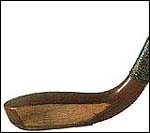 A few putters stamped both "Forgan" and "Philp" are known. In the past,
these clubs were believed to signify the result of a business partnership
during Philp's lifetime. This is not correct. These clubs were made by
Robert Forgan & Son years after Philp's death, out of respect for the
inheritance of Philp's business and the continued popularity of Philp's
clubs, especially his putters. It was also good business for Forgan to
remain linked to Philp. Philp/Forgan putters were produced briefly during
the 1890s as indicated by their fork splice and awkward head shape which
does not begin to resemble anything made by the master himself. Also, the
"H. Philp" lettering stamped on those clubs is unlike anything found on
a genuine Philp. Although recently reshafted and rewhipped, the circa 1850
Philp clubhead on this page is a solid example. Its lines are graceful
and elegant, and Philp's original finish remains untouched. A wonderful
article recalling Hugh Philp, originally cited as from "Chambers Journal,
1859," was reprinted in 1899. Titled "Hugh Philp The Master," it provides
an illuminating glimpse into his daily life. It reads in part:
A few putters stamped both "Forgan" and "Philp" are known. In the past,
these clubs were believed to signify the result of a business partnership
during Philp's lifetime. This is not correct. These clubs were made by
Robert Forgan & Son years after Philp's death, out of respect for the
inheritance of Philp's business and the continued popularity of Philp's
clubs, especially his putters. It was also good business for Forgan to
remain linked to Philp. Philp/Forgan putters were produced briefly during
the 1890s as indicated by their fork splice and awkward head shape which
does not begin to resemble anything made by the master himself. Also, the
"H. Philp" lettering stamped on those clubs is unlike anything found on
a genuine Philp. Although recently reshafted and rewhipped, the circa 1850
Philp clubhead on this page is a solid example. Its lines are graceful
and elegant, and Philp's original finish remains untouched. A wonderful
article recalling Hugh Philp, originally cited as from "Chambers Journal,
1859," was reprinted in 1899. Titled "Hugh Philp The Master," it provides
an illuminating glimpse into his daily life. It reads in part:
Could the past be relived, you might
enter Hugh's shop with me; as it is, do so in fancy. It is not a very commodious
habitation, being a small square box erected on the convenient brink of
the course at the commencement of the links. Round the walls are ranged
boxes filled with finished clubs for the golfer to choose from; piles of
embryo handles and heads, and quantities of doubtful material, yet undeveloped,
strew the ground; overhead are horizontal racks of clubs belonging to some
of Hugh's customers, who claim a kind of prescriptive right to keep their
sets in his shop; and in one corner is Hugh's own particular bench. The
shop is evidently a place where golfers of all descriptions . . . congregate;
caddies waiting engagements, gentlemen players smoking their pipes, chatting
with Hugh, or selecting their clubs. Hugh himself is polishing and stamping
his name on some clubheads. For many and many a year to come these letters
which he is branding on the clubs will serve for Hugh's best epitaph, and
golfers yet to be will sigh for the 'touch of that vanished hand' which
fashioned so deftly and so well. He is clad in his invariable snuff-colored
garb, and his silver-rimmed spectacles are pushed upward on his brow. His
keen black eye is glittering with the fun of some golfing story he has
been relating to a group of players. Hugh had plenty of these tales, and
told them with a dry comicality which was irresistible. But you should
have seen Hugh play a match. As a rule, he did not much care about leaving
his shop to play regular matches with gentlemen golfers, but occasionally
took a round when the chances were a little in his favour. Hugh thoroughly
understood both the etiquette and saving policy of the game, and never
if possible took his match before the burn hole, which left only one hole
more to play. He could, therefore, with every degree of plausibility, solace
his beaten opponent with the idea that it was a very, very close match-indeed,
that there was no saying how the next might go. . . . (Golfing, 16 Nov.:
24).

 The exquisite Philp putter pictured here was once part of an unused set
of nine Philp clubs presented by Sir Hew Dalrymple, Bart., of Luchie, to
John E. Laidlay, a two-time British Amateur Champion and runner-up in the
1893 British Open. Recognized as a one of a kind, Laidlay's set of nine
Philps was displayed, at the request of the Reverend John Kerr, at the
Glasgow International Exhibition of 1901. It was also at Reverend Kerr's
suggestion that the archaeology committee of the Glasgow International
Exhibition included an exhibit on golf. In return, the committee put Kerr
in charge of preparing the display. The Glasgow International Exhibition
of 1901 opened in May and ran for six months. To allay the fears of lenders,
their golf treasures were housed in an isolated, fireproof structure, lighted
throughout by electricity and guarded day and night. (Upon completion of
the exhibition, the structure was to remain as a permanent art gallery
and museum.) Within this grand building the "Laidlay" Philp clubs were
displayed in their own special case. It was recognized, even then, that
Laidlay's Philps were of greater significance than the normal relic. In
1981 John Laidlay's set of Philp clubs was broken up-each club was sold
individually at a Sotheby's golf auction in London, England. The certificate
the Glasgow International Exhibition presented to Laidlay for lending his
clubs was auctioned as the lot following the last of the nine Philps. It
is believed that Laidlay's Philps were crafted in the early 1850s with
the aid of Philp's assistant, Robert Forgan. Such nine club sets were known
to be awarded as "prize clubs" to the winner of a competition (see Smith
1867, 11 & 18). Although this putter has never been used, the lead
in the back of the head has shifted slightly. This is not an unusual phenomenon
and can occasionally be found in other clubs. The head on this Philp putter
measures 5 3/4 inches long, 2 1/8 inches wide, and only 15/16 of an inch
in face depth.
The exquisite Philp putter pictured here was once part of an unused set
of nine Philp clubs presented by Sir Hew Dalrymple, Bart., of Luchie, to
John E. Laidlay, a two-time British Amateur Champion and runner-up in the
1893 British Open. Recognized as a one of a kind, Laidlay's set of nine
Philps was displayed, at the request of the Reverend John Kerr, at the
Glasgow International Exhibition of 1901. It was also at Reverend Kerr's
suggestion that the archaeology committee of the Glasgow International
Exhibition included an exhibit on golf. In return, the committee put Kerr
in charge of preparing the display. The Glasgow International Exhibition
of 1901 opened in May and ran for six months. To allay the fears of lenders,
their golf treasures were housed in an isolated, fireproof structure, lighted
throughout by electricity and guarded day and night. (Upon completion of
the exhibition, the structure was to remain as a permanent art gallery
and museum.) Within this grand building the "Laidlay" Philp clubs were
displayed in their own special case. It was recognized, even then, that
Laidlay's Philps were of greater significance than the normal relic. In
1981 John Laidlay's set of Philp clubs was broken up-each club was sold
individually at a Sotheby's golf auction in London, England. The certificate
the Glasgow International Exhibition presented to Laidlay for lending his
clubs was auctioned as the lot following the last of the nine Philps. It
is believed that Laidlay's Philps were crafted in the early 1850s with
the aid of Philp's assistant, Robert Forgan. Such nine club sets were known
to be awarded as "prize clubs" to the winner of a competition (see Smith
1867, 11 & 18). Although this putter has never been used, the lead
in the back of the head has shifted slightly. This is not an unusual phenomenon
and can occasionally be found in other clubs. The head on this Philp putter
measures 5 3/4 inches long, 2 1/8 inches wide, and only 15/16 of an inch
in face depth.
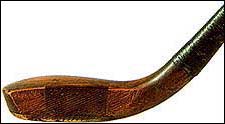
(This web layout does not follow the book layout. Locations
and quality of clubs do not match the highly detailed printed pages.)

 This
genius made such beautiful and perfect wooden putters that he has come
to be regarded as the Amati or Stradivarius of Golf, and a genuine "Philp"
today is worth untold gold. The long narrow faces of these clubs and their
perfect balance are well known to connoisseurs (Golf Illustrated, 5 Oct.
1900: 12).
This
genius made such beautiful and perfect wooden putters that he has come
to be regarded as the Amati or Stradivarius of Golf, and a genuine "Philp"
today is worth untold gold. The long narrow faces of these clubs and their
perfect balance are well known to connoisseurs (Golf Illustrated, 5 Oct.
1900: 12).
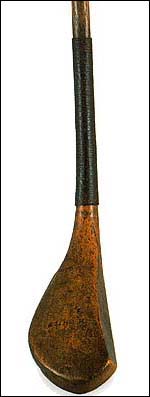
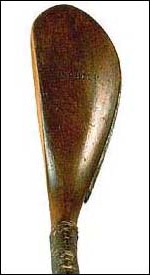

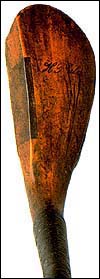
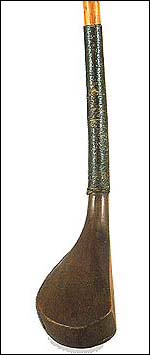

 A few putters stamped both "Forgan" and "Philp" are known. In the past,
these clubs were believed to signify the result of a business partnership
during Philp's lifetime. This is not correct. These clubs were made by
Robert Forgan & Son years after Philp's death, out of respect for the
inheritance of Philp's business and the continued popularity of Philp's
clubs, especially his putters. It was also good business for Forgan to
remain linked to Philp. Philp/Forgan putters were produced briefly during
the 1890s as indicated by their fork splice and awkward head shape which
does not begin to resemble anything made by the master himself. Also, the
"H. Philp" lettering stamped on those clubs is unlike anything found on
a genuine Philp. Although recently reshafted and rewhipped, the circa 1850
Philp clubhead on this page is a solid example. Its lines are graceful
and elegant, and Philp's original finish remains untouched. A wonderful
article recalling Hugh Philp, originally cited as from "Chambers Journal,
1859," was reprinted in 1899. Titled "Hugh Philp The Master," it provides
an illuminating glimpse into his daily life. It reads in part:
A few putters stamped both "Forgan" and "Philp" are known. In the past,
these clubs were believed to signify the result of a business partnership
during Philp's lifetime. This is not correct. These clubs were made by
Robert Forgan & Son years after Philp's death, out of respect for the
inheritance of Philp's business and the continued popularity of Philp's
clubs, especially his putters. It was also good business for Forgan to
remain linked to Philp. Philp/Forgan putters were produced briefly during
the 1890s as indicated by their fork splice and awkward head shape which
does not begin to resemble anything made by the master himself. Also, the
"H. Philp" lettering stamped on those clubs is unlike anything found on
a genuine Philp. Although recently reshafted and rewhipped, the circa 1850
Philp clubhead on this page is a solid example. Its lines are graceful
and elegant, and Philp's original finish remains untouched. A wonderful
article recalling Hugh Philp, originally cited as from "Chambers Journal,
1859," was reprinted in 1899. Titled "Hugh Philp The Master," it provides
an illuminating glimpse into his daily life. It reads in part:

 The exquisite Philp putter pictured here was once part of an unused set
of nine Philp clubs presented by Sir Hew Dalrymple, Bart., of Luchie, to
John E. Laidlay, a two-time British Amateur Champion and runner-up in the
1893 British Open. Recognized as a one of a kind, Laidlay's set of nine
Philps was displayed, at the request of the Reverend John Kerr, at the
Glasgow International Exhibition of 1901. It was also at Reverend Kerr's
suggestion that the archaeology committee of the Glasgow International
Exhibition included an exhibit on golf. In return, the committee put Kerr
in charge of preparing the display. The Glasgow International Exhibition
of 1901 opened in May and ran for six months. To allay the fears of lenders,
their golf treasures were housed in an isolated, fireproof structure, lighted
throughout by electricity and guarded day and night. (Upon completion of
the exhibition, the structure was to remain as a permanent art gallery
and museum.) Within this grand building the "Laidlay" Philp clubs were
displayed in their own special case. It was recognized, even then, that
Laidlay's Philps were of greater significance than the normal relic. In
1981 John Laidlay's set of Philp clubs was broken up-each club was sold
individually at a Sotheby's golf auction in London, England. The certificate
the Glasgow International Exhibition presented to Laidlay for lending his
clubs was auctioned as the lot following the last of the nine Philps. It
is believed that Laidlay's Philps were crafted in the early 1850s with
the aid of Philp's assistant, Robert Forgan. Such nine club sets were known
to be awarded as "prize clubs" to the winner of a competition (see Smith
1867, 11 & 18). Although this putter has never been used, the lead
in the back of the head has shifted slightly. This is not an unusual phenomenon
and can occasionally be found in other clubs. The head on this Philp putter
measures 5 3/4 inches long, 2 1/8 inches wide, and only 15/16 of an inch
in face depth.
The exquisite Philp putter pictured here was once part of an unused set
of nine Philp clubs presented by Sir Hew Dalrymple, Bart., of Luchie, to
John E. Laidlay, a two-time British Amateur Champion and runner-up in the
1893 British Open. Recognized as a one of a kind, Laidlay's set of nine
Philps was displayed, at the request of the Reverend John Kerr, at the
Glasgow International Exhibition of 1901. It was also at Reverend Kerr's
suggestion that the archaeology committee of the Glasgow International
Exhibition included an exhibit on golf. In return, the committee put Kerr
in charge of preparing the display. The Glasgow International Exhibition
of 1901 opened in May and ran for six months. To allay the fears of lenders,
their golf treasures were housed in an isolated, fireproof structure, lighted
throughout by electricity and guarded day and night. (Upon completion of
the exhibition, the structure was to remain as a permanent art gallery
and museum.) Within this grand building the "Laidlay" Philp clubs were
displayed in their own special case. It was recognized, even then, that
Laidlay's Philps were of greater significance than the normal relic. In
1981 John Laidlay's set of Philp clubs was broken up-each club was sold
individually at a Sotheby's golf auction in London, England. The certificate
the Glasgow International Exhibition presented to Laidlay for lending his
clubs was auctioned as the lot following the last of the nine Philps. It
is believed that Laidlay's Philps were crafted in the early 1850s with
the aid of Philp's assistant, Robert Forgan. Such nine club sets were known
to be awarded as "prize clubs" to the winner of a competition (see Smith
1867, 11 & 18). Although this putter has never been used, the lead
in the back of the head has shifted slightly. This is not an unusual phenomenon
and can occasionally be found in other clubs. The head on this Philp putter
measures 5 3/4 inches long, 2 1/8 inches wide, and only 15/16 of an inch
in face depth.
